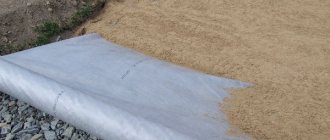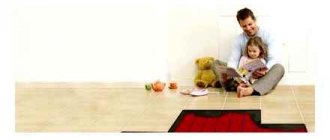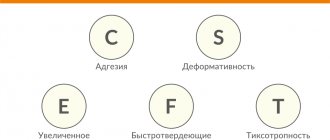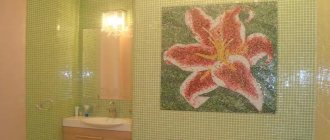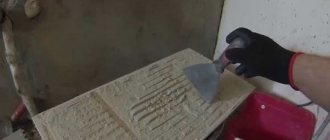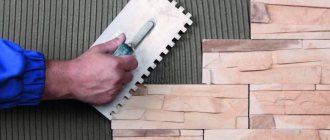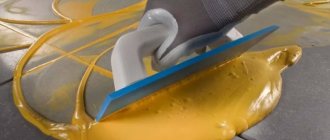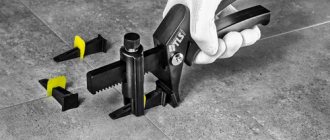When renovations begin in an apartment or private house, you have to go around more than one hardware store in search of the necessary building materials, and the issue is not only in the decorations, tiles or wallpaper, but also at the heart of it all. How correctly the adhesive mixture is selected will determine the quality of the repair and how long it will last. Let's look at the features and scope of elastic tile adhesive, how it can help with repair work and what limitations it has.
Why are elastic mixtures needed?
Cladding with elastic glue occurs if the base is flexible or movable, for example, not a solid wall, but plywood, or the “shrinkage” of the house has not yet occurred, this applies to new buildings. Even if you buy a good cement-based tile adhesive, after a year or two the decoration will begin to crack or “slip” off the wall, and that’s because the adhesive base was not elastic enough.
The mixture must adapt to deformable substrates, so when choosing tile adhesive, pay attention to elastic properties .
Physico-mechanical properties of mixtures
The elastic mixture is a dry powdery substance, white or gray in color, it all depends on the component. But manufacturing plants also offer the consumer a ready-made mixture that is ready for facing work and does not need to be mixed with water.
Average mixture characteristics:
- density value - from 1400 to 1500 kg/m³;
- consumable properties - from 1.3 to 2 kg per 1 m² square;
- adhesion level value - from 1 to 1.5 MPa;
- cycles in which elevated temperatures are maintained - 80-90;
- strength properties - from 4 MPa;
- maximum shift is 0.6 mm.
The physical and mechanical properties of the elastic adhesive mixture are suitable for laying tiles in entrances, on basement floors, in production facilities, bathrooms and swimming pools.
Review of manufacturers
In the modern finishing materials market, there are companies that have been producing elastic adhesive for a long time and have an excellent reputation. Most often, their products are overpriced and no less high quality. However, there are also young brands that also supply high-quality elastic adhesive to the market.
Litokol
This manufacturer produces several types of adhesive mixtures:
- dispersion elastic compositions intended for laying ceramics on bases made of different materials (plaster, drywall, cement or concrete screed);
- cement-based mixtures suitable for laying marble, ceramics, mosaics, porcelain tiles on concrete and cement bases;
- two-component solutions based on epoxy components (reactive mixtures), with which you can lay not only ceramics, but also wood, PVC and other materials.
The glue of this brand has excellent performance properties. Litocol products have increased resistance to temperature changes and mechanical loads, which allows them to be used in the finishing of public and commercial buildings.
Mapei
This glue has high quality and good technical characteristics. The Italian manufacturer offers the following types of elastic adhesive compositions:
- Keracrete. A two-component type of mass, characterized by a cement base. This product is highly resistant to slipping. Most often used for laying mosaics and natural stone elements.
- Granirapid. To prepare this composition, you need to mix 2 components (cement mixture and rubber latex). Suitable for both indoor and outdoor use. Sets quickly. However, the prepared mixture must be used immediately, because it loses its adhesive properties within a short time.
- Keralastic-T. Gray or white paste consisting of 2 components. The finished mixture is sold in 5- or 10-kg containers. Contains polyurethane, which provides a high level of thixotropy and moisture resistance of the adhesive. Suitable for laying massive tiles made of natural and artificial stone, porcelain tiles and mosaics. Can be used for exterior and interior decoration.
- Keraflex Maxi. Dry one-component composition with improved properties. Has no vertical slip. It does not lose its characteristics for a long time. The working mixture is prepared by diluting the powdered substance with clean water.
Ceresit
These products are suitable for all types of interior and exterior decoration. Main properties of Ceresit adhesive:
- high resistance to negative temperatures and moisture;
- good elasticity and resistance to deformation loads;
- can be used for laying old tiles;
- does not contain toxic substances;
- suitable for plasterboard, OSB, fiberboard and chipboard;
- Can be used on heated screeds.
The adhesive from this manufacturer is suitable for fixing any types of mineral tiles.
Kiilto
The manufacturer offers the following types of adhesive mixtures:
- Pro FIX. Suitable for laying tile products on concrete, gypsum, aerated concrete, plaster (cement). Can be used for lining swimming pools. The manufacturer recommends combining this glue with the special MixPul filler. This combination allows you to achieve maximum coating strength.
- Ultra fix. It is used for cladding with mineral wool or polystyrene foam boards, clinker, natural stone, etc. The adhesive composition has excellent resistance to negative temperatures. Used to level the surface before finishing.
- Master fix. Used for finishing with mosaics, tiles, ceramics. Plasterboard sheets, old tiles, and concrete can be used as a base. Using Master Fix you can glue products made of mineral wool and polystyrene foam. The mixture is moisture resistant and fire safe. Sold ready-made.
- PL-250. Two-component mixture based on polyurethane. Used for insulating concrete, metals, PVC, fiberglass, wood and ceramics. After applying this glue, the seams are strong and elastic. Apply with a spatula.
- Super W. Suitable for gluing polystyrene foam, mineral wool, glass mosaics, stone and tiles. The composition is white in color and contains filler. However, this mixture quickly breaks down when exposed to moisture.
- FIX. Frost and moisture resistant glue. Suitable for both internal and external cladding of surfaces with ceramics, mosaics and tiles.
- ECO FIX. Contains Portland cement and quartz sand. Most often used for interior decoration of walls and floors with ceramics. Concrete, aerated concrete, brick, foam concrete and plaster can be used as a base.
Knauf
The products of this brand are excellent for cladding complex surfaces. It can be used to install any type of tile. The demand for Knauf elastic adhesive mixtures is due to their high elasticity and affordable cost.
Ilmax
This composition is manufactured in Belarus. Its high demand is due to its good quality and low price. Ilmax glue contains special fillers that make it possible to lay tiles even in fireplaces and stoves. At the same time, the mixture does not lose its performance properties for a long time when exposed to high temperatures.
Bergauf
Experts note that the products of this brand are most suitable for laying “capricious” materials, including transparent tiles and mosaics. The mixture is white in color and tolerates high humidity well. In addition, she is not afraid of even direct contact with moisture.
The elastic adhesive must be applied to a dry surface. By adhering to the correct application and installation technology, you can achieve a high-quality result, in which case the cladding will last for decades.
Glue Features
The components in the composition act as a plasticizer for tile adhesive; it is also called polyurethane with two components. The components of the glue are special hardeners and polyurethane resins. When mixing the components, an adhesive solution for deformable surfaces is obtained. Mix two-component adhesive using construction mixers or a drill, while wearing a specialized attachment for mixing construction materials.
If you read the instructions for the glue, it says that the glue dries within 30 minutes, but you shouldn’t rush and it’s better to give the mixture more time for 1-2 days, then the surface will be securely fixed and you can continue construction work.
Glue is a highly elastic material; it can be used to glue things that are held in place only by screws or nails. A gel-like plastic mass, this is what the structure of the mixture looks like.
Suitable for use in everyday life and on construction sites; it will hold old tiles that have a glazed structure.
What to consider when choosing porcelain tiles
If porcelain stoneware is chosen as the main material, then finishing work is recommended to be carried out exclusively with compositions based on components. providing the required elasticity.
This also includes finishing work on terraces, fireplaces and other things where there is always a thermal difference. In this case, the glue acts as a linear restraining factor, preventing cracks and voids from appearing.
- It is worth sticking to the thickness of the adhesive layer. Which is recommended by the manufacturer, then the cladding will be both high-quality and reliable.
- Half a centimeter is enough when laying, but if you put more, there is a risk of shrinkage with the formation of voids.
- By using a spatula with teeth, you can easily ensure normal distribution of the adhesive composition.
When finishing the floor surface, it is necessary to take into account the force with which the slabs will adhere to the base.
This information is given on the packaging. The large format of the tiles must be combined with good adhesive properties of the composition.
Scope of application
Polymer adhesive is used for minor construction repairs and during construction; some types of mixtures are used for repairing automobile glass. When choosing a transparent solution, it can not only reliably glue the surface, but also not leave marks. It is a good camouflage for cracks and does not interfere with visibility when driving a car.
It is applied for:
- concrete having a cellular structure;
- chipboard;
- cement particle boards;
- drywall;
- plywood;
- aerated concrete;
- old tiles;
- concrete screed;
- wood;
- porcelain stoneware;
- marble and glass mosaics;
- acid-resistant and clinker tile products.
How to prepare the solution
The preparation of a solution from a dry mixture must be carried out strictly according to the manufacturer’s instructions on the packaging of the product. The ratio of the components is written down on it; small portions of the glue should be prepared so that it does not have time to harden during work.
The preparation of a solution from a dry mixture must be carried out strictly according to the manufacturer’s instructions on the packaging of the product.
Limitations in use
Polymer adhesive is considered universal, but its use is not always possible, for example, for heated floors and places with constant heating, it is better not to use the mixture. This can lead to the glue starting to melt and the surface to collapse.
For ceramics and porcelain stoneware, you need to choose an adhesive with the appropriate marking; adhesive for tiles and wood flooring will not work.
Which is better
Almost every manufacturer that produces adhesive compositions has adhesive for laying porcelain tiles. And often not one, but several. How to choose the best adhesive for porcelain tiles? The parameters are described above. But several compositions can correspond to them. Or even several dozen. In this case, you are determined by reviews or additional characteristics, such as longevity, ease of installation, etc. Another criterion is availability in your region.
Don't buy unknown brands. Yes, they are cheap. But the result is unpredictable. And porcelain stoneware is an expensive material. If it cracks, replacement will cost a pretty penny.
Let's list the “normal” brands that you can work with.
- BAULUX for porcelain tiles. There are several varieties for different sized slabs.
- Eunice. Relatively inexpensive, but not very convenient to work with - it is harsh and quickly begins to harden.
- Litokol. K80 is quite acceptable in terms of characteristics for laying medium format slabs inside the house. For long narrow tiles, when laying on a warm floor or outdoors, it is better to take K77, K100. These brands are more flexible.
- Ceresite for porcelain tiles and heated floors. These are SM16 and SM17. The second one is better, but also more expensive. Also be careful - it is easy to buy a fake with completely inadequate properties.
- Mapei. Factories are in Russia, but prices are comparable to imported ones. Although the quality is not bad.
- Profit. It takes a long time to set, but then you can’t tear it off.
- Superbond. Seems rude to some.
- Eunice+. Good, but expensive.
- MASTPLIX T-12 BASIC. Normal consumption.
- Knauf Flex. One of the best lineups. Also suitable for laying porcelain stoneware on heated floors.
Choosing a material manufacturer is not the easiest task. Above is a list of those brands that usually receive good reviews.
Laying principles
How to lay tiles with elastic adhesive on wood plywood.
- Wooden layers with a thickness of 25 mm or more must first be laid on the beam and secured with self-tapping screws. We place the beams closer to each other, a distance of approximately 50 cm.
- Dust and other contaminants are removed from the surface, then a primer is applied and left to dry.
- Apply the adhesive base on top of the floor.
- Then apply the mixture to the back of the tile with a notched trowel; no need to use a thick layer.
- Next, the tiles are laid on the surface; if the tiles have a pattern, immediately prepare the order in which they go.
- We wait for the glue to dry completely and start grouting; special mixtures are sold for this.
- After the repair work is completed and the grout has dried, wet cleaning is carried out.
General recommendations for gluing
To obtain reliable adhesion, the surface that will be glued is well cleaned of all types of contaminants, and degreasing is also carried out. This helps to obtain a connection without the interference of unnecessary elements. If it is expected that in the future the object will be exposed to high humidity, then a primer solution is first applied.
You can only spread the glue onto a dry surface, making sure that the layer is even.
The parts lubricated with glue are connected together and kept in this position for a certain time, which is also prescribed by the manufacturer in the instructions for use. Operation of the item is possible after the composition has completely set.
There are products that add toxic substances to obtain better results; working with them requires compliance with safety precautions. The technician must not only put on a respirator, but also rubber gloves, and make sure that the ventilation in the room is of good quality.
To obtain reliable adhesion, the surface that will be glued is well cleaned of all types of contaminants, and degreasing is also carried out.
Polymer adhesives are diverse, and they make it possible to glue many materials. They are easy to work with, and the quality of the connection allows the glued item to be used for many years. It is important to choose the appropriate type based on the task at hand and operating conditions.
